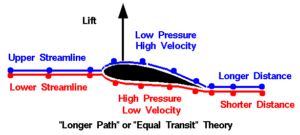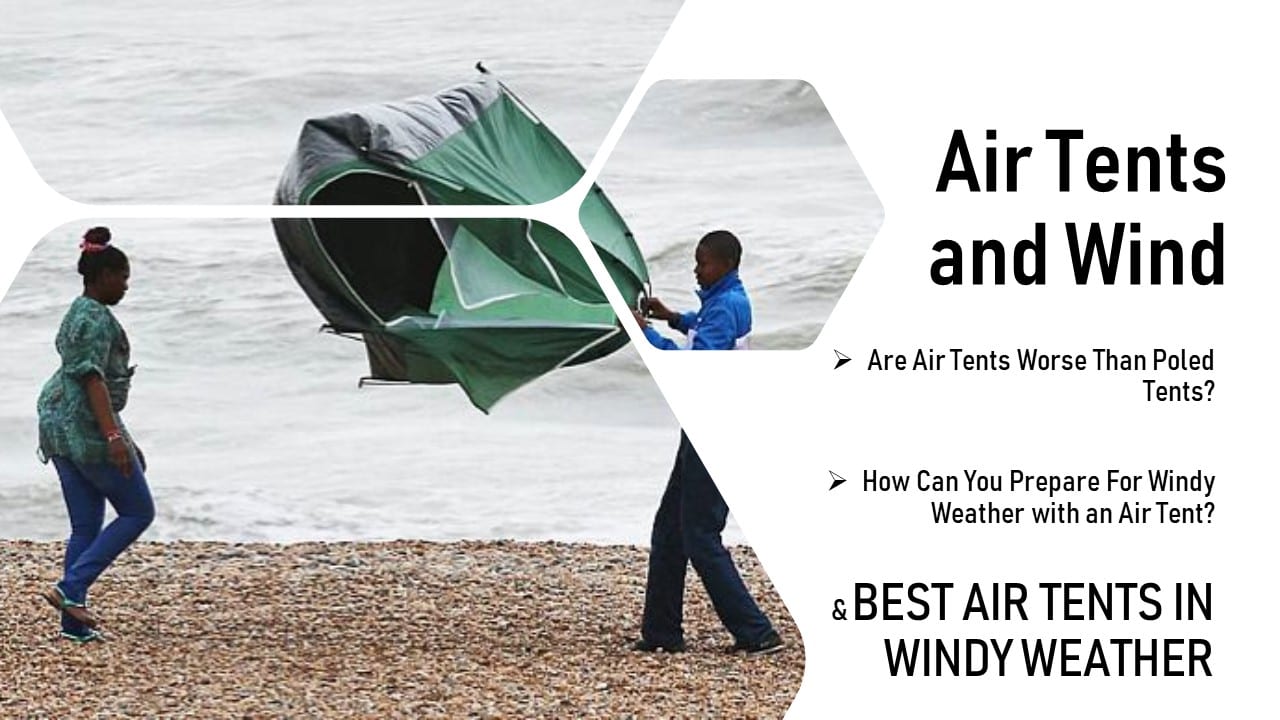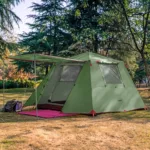You may wonder, what air tents are like in windy weather? Which ones are the best air tents for windy weather?
The worry is understandable: inflatable tents are lighter than the traditional pole tents, most people associates to bouncy castles flown away by the wind. I must admit, watching my air tent waving like a flag in the wind is not something I would ever like to experience. Ever.
There are some golden rules though, that you must follow – no matter if you had an air tent or a pole tent – to ensure that the tent remains in place in strong winds.
In this post I tried to cover:
- How air beam tents perform in bad weather compared to poled tents
- Why tents collapse in wind in general
- Why your air tent is collapsing in wind and how to prevent it
- Best performing air tents in high wind
If you haven’t already, you should have a look at the previous episodes:
Part 1: Best air Tents UK / US / AUS
Part 2: Best air tents / inflatable tents with blackout bedroom
Part 3: Best air tents with sewn-in groundsheet
Part 4 (this post): Best air tents in wind
Airbeam Tent vs. Pole Tents is Bad Weather
Thanks to the flexibility provided by the inflated poles, inflatable tents can withstand strong winds very well. It does not mean that they won’t deform under the wind-pressure, but the airpoles are flexible enough to bend and stretch and then come back to their normal shape, without the risk of anything ie fibreglass poles snap under the tension.
If and when a traditional poled tent collapse, they stay collapsed!
Why Tents Collapse in Wind – General
There is a scientific explanation, and there are practical reasons.
The scientific explanation is just physics:
- the wind gets under the fabric and turns your tent into a sail. This can happen either if there’s a gap between the ground and the groundsheet, or if the wind gets inside the tent through the door or the windows; or
- the pressure of the air is lower in the wind because of the speed of it, creating low pressure above the tent. The pressure on the other side of the flysheet – inside the tent – will be higher, creating a force that pushes the tent upwards, towards the lower pressure. This is how airplanes fly: the curve of the wing increases the speed of the air above the wing, creating a force the lifts the wing upwards.

Air tents can fly away in the wind like a plane. Physics is physics.
The practical reasons are just as simple;
- Tent is not secured to the ground
- Tent is not oriented well, creating too big a surface and catching the wind
- Tent is not pitched properly
For an airbeam tent, there are some specific requirements that you must be aware of as they ultimately affect the stability of the tent, which I talk about a bit later on.
Weight (water) – polycotton and canvas tents
One thing to bear in mind that polycotton and canvas tents will become wet in rain, thus increasing their weight. This can ultimately affect the stability of the tent in high winds: they may be more susceptible to collapsing under the weight and wind-pressure.
How To Peg Out Your Tent For Windy Weather?
There are few things to consider here:
If you pull the tent down too much (too tight), if you don’t peg it out tight enough, ground conditions / quality of pegs, quality of guy lines, angle of guy-lines, orientation.
Pegged too tight
If the shape is deformed and the guy lines tightly pull the whole tent downwards, the airbeams may lose the flexibility they need to ride out heavy gusts. Not just that, but the increased pulling force on the welding / stitching and the lack of flexibility together may increase the likelihood of material fatigue. Typically when you’d need the fabric to withstand, it will tear or break (ie. where the guylines are attached to the flysheet), if it is not the guy line that snaps first.
Pegged too loose
Kinda’ obvious, but if the wind starts bouncing the whole tent, it does not matter how flexible the beams are.
Ground conditions / quality of pegs
Ground conditions are critical. Not just if the ground is saturated, which most of the time increases the chance of the pegs pulling out ever so slightly in high wind.
Even if there’s no rain to soak the ground, the type of the soil can impact the stability of your tent in high wind very much: a sandy soil with relatively large particles will less likely keep the peg in ground.
With other soil types that have more clay particles (10 times smaller than the particles in a sandy soil), water – up to a point – can actually be beneficial: the small clay particles grow slightly and keep the water on their surface. This will make the ground fully saturated, with no air present. If you ever stuck in mud with a welly-boot, it’s the same principle: if you wanted to pull it out, there would be no air in the void under the boot, in other words, you would create a vacuum. This would suck your wellies back, that’s why it’s so difficult to get them out of the mud.

Clay soil may hold your wellies, but not the pegs
This only works as long as air cannot get into the void.
On the other hand, in windy weather, when the rain stops, the wind would quickly start drying out the top layer of the soil. The clay particles would get rid of the water on their surface, thus reducing the volume of the soil significantly. So the peg that was perfectly driven in to the slightly wet ground, will suddenly sit loose in a hole that contracts as the soil dries out…
So you need pegs, that;
- go deep enough
- able to create that void inside the ground
- less likely create a hole around themselves as they are being moved slightly
To cut the long story short: if you prepare for high winds, make sure you use a full set of quality, heavy duty pegs – I recommend these storm pegs on Amazon. Depending on the type of soil, your stake may give a stronger hold if you drive it into the ground vertically. Don’t bury the entire stake in the ground.
If the ground is hard, use a rock or hammer to push down your stake. Make sure you have extra stakes just in case.
For sandy or snowy environments, make sure you bring sand/snow anchors.
Quality of Guy Lines
Even the best / most expensive inflatable tent can be blown away by the wind if the guy lines are not strong enough and snap. I heard a story of a Zempire TXL Pro getting ruined by the wind, just because the guylines snapped. Then on, the wind toyed with the tent, damaging the flysheet and the airpoles, basically rendering the whole tent useless.
So make sure that you have quality guy lines. Not necessarily 550s, but get decent, thick guylines, £10-20 worth of investment can save you hundreds if not more.
Angle of the Guy Lines
The guy lines should always follow the angle of the anchor points as a straight line. If the angle is acute or obtuse, it can create undesired tension at the point where the anchor point is attached to the flysheet, causing material fatigue that can shorten the life of the fabric.
Use Extra Guy Ropes and Pegs
Guy ropes and pegs are used to secure your tent to the ground. They help ease the tension on your tent. Make sure you use all the ropes provided. Also, use more ropes and peg as the more you use, the better security your tent has
Orientation
As a rule of thumb, you should pitch you tent with its back to the wind direction. This will prevent the wind pick up the tent as soon as you open the front door, and minimizes the surface that the wind can catch.
Set Up in a Sheltered Spot
Instead of open space, try to set up your tent under of close to a shelter. When you set up in a sheltered spot, it can act as a windbreaker and protect your tent from dangerous winds.
Awnings
Most tents come with an option to cover/zip up the front awning or veranda. If you have this option, use it. This will prevent the wind from getting under your tent and lifting it away.
My Air Tent Is Collapsing in Wind, What Can I Do?
There may be a few specific reasons why an airbeam tent collapses in wind:
- Not enough pressure in the beams
- Beam is out of shape
It could be something as simple as not enough air in the beams or a twist in the tube, which could create a kink and make the beams susceptible to collapsing.
According to Vango for example, what you can do is deflating the beam and remove from the tent, re-inflate and pressure to 1 PSI above the recommended limit of your tent (remove the pressure valve if required). When inflated out of the tent, check for twists in the inner tube, a bend in the beam indicates some kind of issue with the tube.
If there is an issue with the tube then opening the sleeve and ensure the tube is flat inside the sleeve and is inserted all the way to the sleeve end and folded back if necessary.
Re- inflate the tube / beam, and make sure the end guylines are pulling the end beams apart. (i.e. away from the centre of the tent)
This may not be feasible if you are at the campsite, and the wind is about to blow your gear away while you are standing above the ruins of your collapsed airbeam tent.
General advice: if higher winds are expected, increase the pressure slightly in the airbeam, slightly above the recommended value. Always check the manufacturer’s instruction on ‘what is normal pressure’, as it is different for every air tent, even between two models of the same make. For example, if the standard pressure in the beams is 7psi, you could increase the pressure to 8psi.
To achieve this, you may need inflate the beams without the dump valve attachment, that comes with the pump. Instead, you should use the gauge to measure the pressure. The needle will rise and fall as the valve in the beams open. While pumping air in, the needle will rise and this will allow you to see when the beam achieves 8psi.
Best Air Tents in Wind
There are a few manufacturers that have some innovative solutions that increase wind- and weather-resistance.
Vango Air Tents Storm Protection
Tension Band System
Vango’s most well-know patented solution is the Inner Tension System called TBS. All Vango tents are equipped with the imprved TBSII tension band system. These are basically straps that you can use to increase the stability of the structure of the tent in high winds. It doesn’t mean that the tent won’t move, because you need some flexibility to tame the forces of the wind, but it limits the movements just as much as necessary.
When you don’t need them, you don’t use them, as simple as that.
Vango used to say that their tents can withstand winds up to 55 mph. I can’t see that statement anymore – may be for legal reasons – but anyways, Vangos are known to be the best tents that you can have in windy weather.
What else?
- Storm anchors on the Amalfi range air tents for example, or on the Vango Taiga 600XL. It means secure guying at the front and rear of the tent. The Amalfi’s have been discontinued in 2020 by Vango, but there’s plenty of stock at a really good price on eBay for example. Vango Amalfi Air Tents on eBay
Related post: Amalfi Air 600 Comparison to other 6-berth Vango air tents.
- Storm skirts on the Icarus Air range inflatable tents – the groundsheet is attached to the flysheet with an external storm skirt to provide all round protection. There are other air tent families that have the storm skirts, like the Keswick 600 air tents, but not all Vango’s have it.
- Line-Lok guyline adjusters – Patented guyline runners. Lightweight, easy to use and will hold firm in windy conditions.
Other Tent Makers
Sprayway – Roof Tension System – Tension straps to the front and back of the tent increase stability for any rough weather. More details on Sprayway Air Tents here.
Kampa – Reinforced pegging and guying points. Great example could be the Kampa Kielder 5 – detailed review here one of my favourite inflatable tents.
Summary
As a rule of thumb, if you can guy your tent out effectively then it should be able to withstand reasonable bad weather, the problem usually come when guylines start to fail or the ground is so saturated the pegs start to pull.
What is a strong wind? I am not going to recite the Beaufort Scale, because what wind is strong hugely depends on what tent you have, and how well-prepared you are.
Even a stronger breeze can damage your tent if it is not set up properly, on the other hand, some air tents can withstand gale force winds (55 mph) if they are secured and pitched carefully.
Air tents are not immune to high winds. They still have to get taken down when the going gets too tough.
The trick is deciding when that point is reached.

